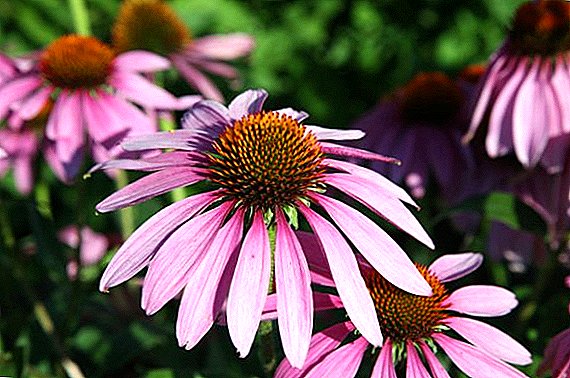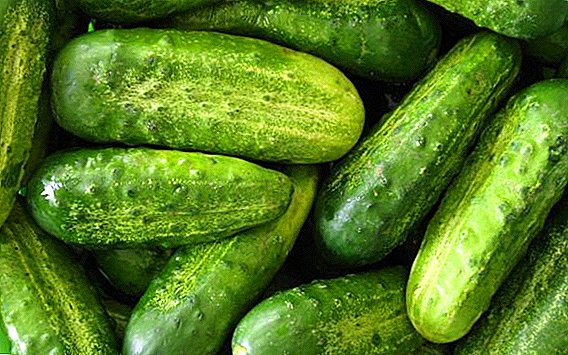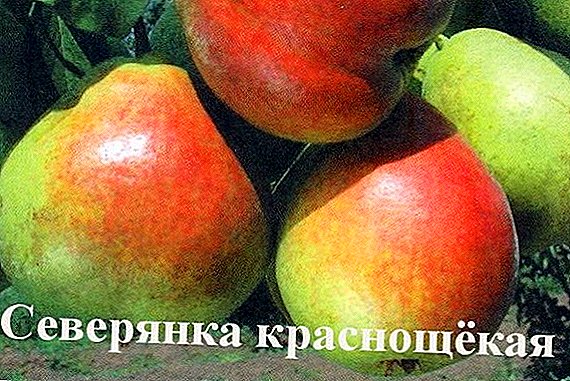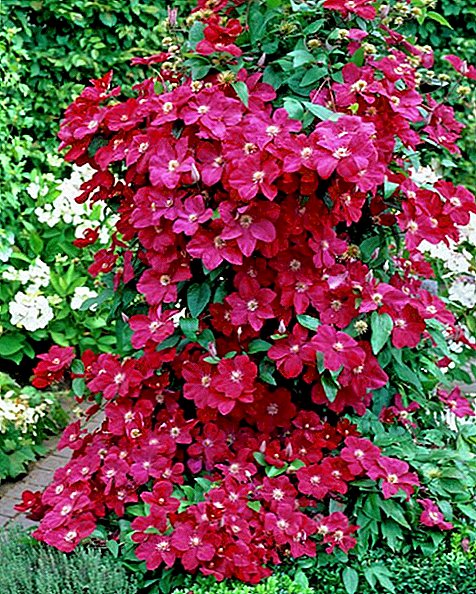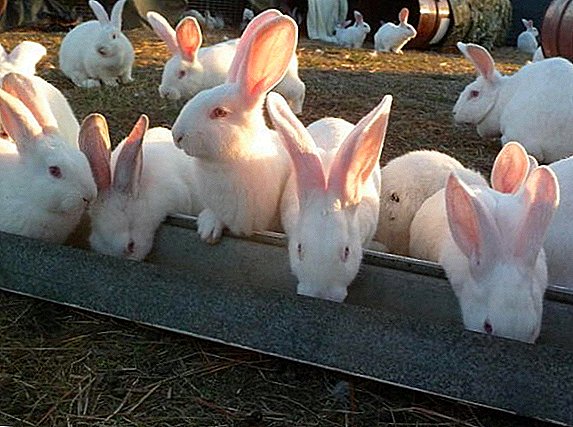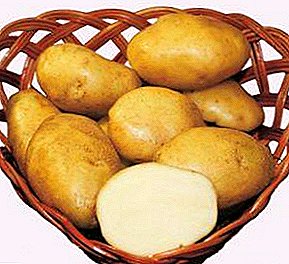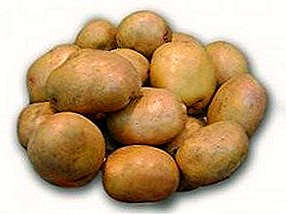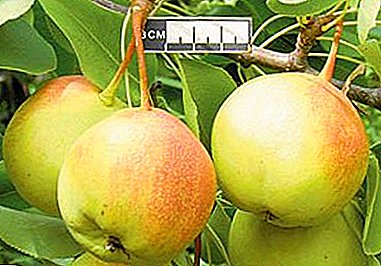
Fragrant small tasty "Karatayevsky" pears settled long ago on the tables of summer residents and gardeners.
Small sweet and sour fruit likewise appealed to both adults and children.
And today we will talk about what kind of variety it is, how to take care of this tree, so that it continues to delight you not only with beautiful yellow-pink pears, but also with a fluffy crown and good harvest.
What kind is it?
 Karataev pear treat early autumn varieties. The fruits are ready for consumption in mid-September, but it is important to remember that their shelf life is very short. And requires a special microclimate to maintain taste and external qualities.
Karataev pear treat early autumn varieties. The fruits are ready for consumption in mid-September, but it is important to remember that their shelf life is very short. And requires a special microclimate to maintain taste and external qualities.
Ripe "Karatayevskaya" pear without proper conditions of detention can spoil in two weeks. However, in the refrigerator the life of the fruit may last. up to two months.
This variety belongs to dessert pears.
The autumn pear varieties also include: Tatyana, Talgar beauty, Uralochka, Otradnenskaya and Thumbelina.
Breeding history and breeding region
Pear "Karatayevskaya" appeared in 1971 through breeding, which produced scientists Kalinina I.P., Karataeva E.P. and Puchkin I.A.
They worked on the base NIIS named after Lisavenko (State Scientific Institution Research Institute of Horticulture in Siberia named after MA Lisavenko). The hybrid received for state trials was sent in 1998. Included in the State Register of the East-Siberian region and submitted in 2012.
The pear was bred as a result of applying to the color of the variety "Granddaughter of Pollen" with "Dessert". And the resulting hybrid perfectly combines the best sides of each of these fruit trees.
Pear "Karataevskaya": description of the variety and photos
 This pear treat to medium fruit treeswhose height (depending on the climatic conditions of detention) varies from 2 to 4 meters.
This pear treat to medium fruit treeswhose height (depending on the climatic conditions of detention) varies from 2 to 4 meters.
The similar structure of the shoots is caused by the weak development of the lateral processes and buds (they have an angular direction and a cone-shaped structure).
The leaves have a neat elongated (ovoid) shape with finely serrated edges. Their color is dark green, and the size is rather average.
Long single thick shoots, painted in reddish and brown shades, with a sheet, creating the effect of a green edge at the ends of the branches, require formative pruning so that the tree does not acquire a skeleton-like shape.
The fruits have a characteristic yellow-pink, ruddy color with a red blurry-streaky traces. The pear shape is round: wide at the base with a short tail. The stalk is long thin and dark.
Weight ranges from 80 to 120 grams. Have bright pronounced sweet-sour taste with sharp spicy notes.
The consistency of the pulp is complex, densely grainy, ivory shade. The fruits are juicy, crunchy with a pleasant aftertaste.
| Composition | amount |
|---|---|
| Sahara | up to 12.2% |
| Acids | up to 0.64% |
| vitamin C | up to 3.3 mg% |
| P-active substances | up to 62.0 mg% |
Seeds are arranged in closed oval capsules. They are small, light brown in color and drop-shaped elongated.
The following varieties of pears can also boast great taste: Duchess, Bere Bosk, Bere Russkaya, January and Fairy.
For more information about the variety and see the pears "Karataevskaya" you can see in the photo below:






Specifications
"Karataevskaya" pear fruits moderately, but regularly. Depending on the conditions (soil quality, irrigation and temperature conditions) in which the tree grows, it can be removed from 15 to 45 kilograms of fruits (average yield 9.3 t / ha).
IMPORTANT: Despite the fact that this hybrid was bred in Siberia, it does not have good frost resistance. And it grows favorably in a mild climate. Also "Karatayevskaya" pear is very sensitive to the lack of moisture. This tree needs attentive care.
 This grade does not require the landing of additional pollinator. His flowers are bisexual. Fruiting begins in the fourth or fifth year of life.
This grade does not require the landing of additional pollinator. His flowers are bisexual. Fruiting begins in the fourth or fifth year of life.
The fruits ripen from 12 to 18 September. At the same time, they can begin to collect and store for storage in a cool dark place.
Rogneda, Rossoshanskaya beautiful, Sverdlovchanka, Chudesnitsa, Tonkovka and Severyanka have good frost resistance.
Planting and care
When planting a pear seedling, it is necessary to consider that it is a heat-loving plant, and try to place it in the least blown and shady place.
Ideally, it should be determined by landing the most south or southeast garden. It’s just as well if this place has some protection from the wind (there may be a fence or a wall near the house).
For pear varieties "Karataevskaya" free space between the sapling and the other trees will be 4-7 meters.
This will allow the pear to get the necessary amount of nutrients from the soil and avoid accidentally weaving roots with other trees, and as a result - parasitizing on each other.
IMPORTANT: If an old or dead tree has recently been removed in a garden, then a sapling should be planted exactly on this place. Good growth and easy survival rate of young pears are guaranteed.
 A very important point before planting is the preparation of the soil. Ideal for pear is sandy-clay medium.
A very important point before planting is the preparation of the soil. Ideal for pear is sandy-clay medium.
But good growth and subsequent harvest will provide brown, gray and brown forest soils. The earth should be thoroughly moistened, loosened and injected with a trophy so that it “breathes”.
Pit size should be meter wide and half meter deep, and, also, should be placed on the bottom ground mixed with peat and fertilized with 18-21 kilograms of manure.
In order for the sapling to have time to grow stronger, grow, and get stronger before the harsh winter blizzards, it is necessary to plant the “Karataevskaya” pear in the spring. However, the pit for planting should be prepared in the fall. When landing in the ground should not be frozen areas.
If the landing is to be in the fall, then they dig a hole in advance, in three weeks.
ATTENTION: Do not plant a pear in the period of prolonged rains! Otherwise, the root system may rot. But at the same time dried up roots need to hold some time in the water to revive them. This will facilitate the survival of the seedling.
When landing a garter peg is driven into a hole in a tree. It should be placed on the south side, and make sure that it does not interfere with the growth and development of the pear. After planting, the seedling must be poured with two buckets of water and carefully tamped down the hole.
 Watering "Karataevskaya" pear in the first year of life is worth Abundant 4-5 times per season (2-3 buckets). Further, a mature tree should be watered 1-2 times per season with rain method.
Watering "Karataevskaya" pear in the first year of life is worth Abundant 4-5 times per season (2-3 buckets). Further, a mature tree should be watered 1-2 times per season with rain method.
In the next year after planting, the trunk should be whitened and the soil should be fertilized. These actions must be carried out in the middle of spring (beginning-middle of March). At the same time worth to prune the tree and form a branched crown.
Diseases and pests
The hybrid "Karataevskaya" pear good resistance to fungal diseases.
The same sign is different: Lyra, Ilyinka, Carmen, Vernaya and Noyabrskaya.
However, there are a number of infections to which they are prone:
- Black Cancer (or "Antonov Fire")
- //selo.guru/ptitsa/bolezni-p/gribkovye/parsha.html
 Black cancer subject to all parts of the tree except the roots.
Black cancer subject to all parts of the tree except the roots.
The branches and trunk are covered with wounds, which, expanding, gradually destroy the tree.
The leaves fall, and the fruits are covered with black rot, shriveling and mummified.
IMPORTANT: Black cancer must be treated to prevent transmission to other fruit trees. Appearing red and brown brown spots must be removed, capturing two centimeters of healthy wood around. The obtained sections should be immediately treated with a solution of copper sulphate.
Scab, if not treated promptly, it can ruin the pear. As in the previous case, this disease can cover the trunk, shoots, buds, leaves, flowers and fruits.
All this can form small spots (from 2-3 mm to 2 cm), which will gradually grow and multiply. Fruits become practically inedible: hard, cracked and very small.
To carry out both preventive and therapeutic spraying of the pear and the earth around it with a 7% solution of urea and Bordeaux mixture. Affected areas of the tree are required removed and burned.
 Also, in order to prevent the development of any diseases in pears, it is necessary to collect and burn fallen leaves every autumn.
Also, in order to prevent the development of any diseases in pears, it is necessary to collect and burn fallen leaves every autumn.
Since they can be not only carriers of viral infections, but also attract pests that can cause the tree no less harm.
The main enemies of the "Karatayevsky" hybrid will be:
- Green aphid.
- Pear sucker or leafblock.
- Pear mite
- Listovertka.
Against these pests spraying is used. There is a mass of modern preparations aimed at the destruction and scaring of insects, but there are also popular recipes that have managed to establish themselves over the centuries.
From Green aphid best helps solution of soap.
Larvae listobloshki kills tobacco dust, a decoction of yarrow or pharmaceutical chamomile.
For pear mite lethal solution of colloidal sulfur.
Vs listworms You can use a steep onion or garlic brew.
 In conclusion, I would like to say that the “Karataevskaya” pear is a wonderful sample of bred hybrids, which managed to establish itself as a tasty, juicy, fragrant fruit filled with vitamins and microelements, and as a neat beautiful tree that with proper care pleases the eye and beautifies any summer cottage plot.
In conclusion, I would like to say that the “Karataevskaya” pear is a wonderful sample of bred hybrids, which managed to establish itself as a tasty, juicy, fragrant fruit filled with vitamins and microelements, and as a neat beautiful tree that with proper care pleases the eye and beautifies any summer cottage plot.
Watch the video about the pear of "Karataevsk" variety.


